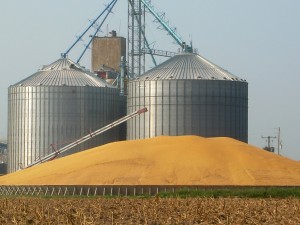While providing grain farmers with loans and safety-net programs is an important function at the U.S. Department of Agriculture (USDA), the agency’s role in protecting the nation’s food supply does not stop when farmers deliver their harvest to the market.
USDA’s Farm Service Agency (FSA) also works with grain elevators to help ensure the proper storage of harvested crops, which – during record harvests as seen in recent years – can save millions of bushels of grain from spoiling.
Corn harvested in 2014 reached a record high of 14.21 billion bushels and soybeans a record 3.96 billion bushels, which made grain storage an important issue across the Great Plains and Corn Belt regions this winter.
As harvest was wrapping up, staff at FSA worked with grain operators in 25 states to establish emergency storage options, a similar number of states compared to 2013 when 13.9 billion bushels of corn and 3.36 billion bushels of soybeans were produced. Ground storage requests from the operators for the 2014 crop totaled 390 million bushels, a record high.
“Emergency-storage approvals allow grain storage operators to properly store corn, wheat and grain sorghum on the ground until warehouse space is made available,” said Commodity Operations Acting Deputy Administrator Sandra Wood. “By working with grain operators, we are helping to ensure as much harvested grain as possible becomes the food, fuel and animal feed that helps drive our nation’s economy and does not go to waste.”
Emergency storage, typically ground piles, helps to provide additional space after harvest when all conventional storage space is filled to capacity. The use of ground piles for grain has been an industry practice during peak harvest seasons for many years.
Warehouse operators have the same responsibilities and liabilities for the quantity and quality of grain stored in emergency storage space as they do for grain stored conventionally.
Wheat, corn and grain sorghum may be stored in ground piles, but not soybeans. Also, grain cannot be stored in emergency ground piles past March 31 as the warm, wet weather puts the grain at more risk for spoilage.
FSA’s involvement with grain storage in temporary locations helps establish quality and safety standards to help ensure the safekeeping and integrity of commodities in storage.
“We are dedicated to making sure the best storage options are available to help elevators preserve harvested grain for as long as possible,” Wood added. “Helping to protect what our farmers worked so hard to produce is an important step in keeping a safe and efficient food supply system.”







One Response to Record Harvests Bring Out the Best in FSA’s Grain Storage Oversight